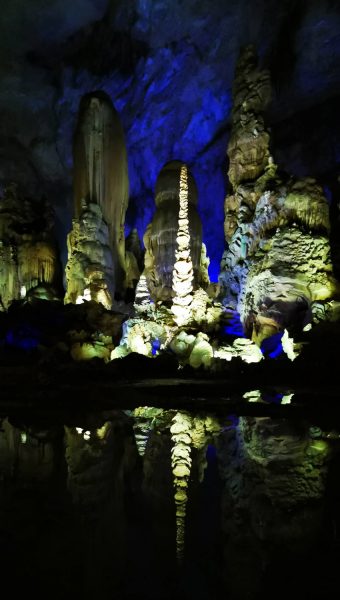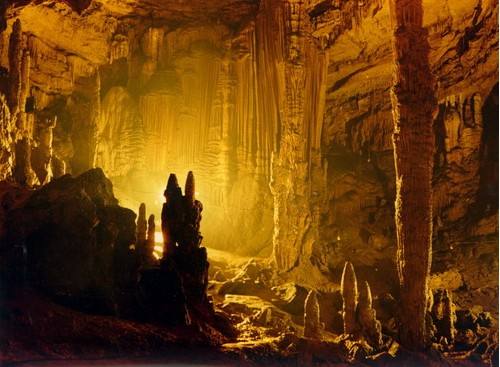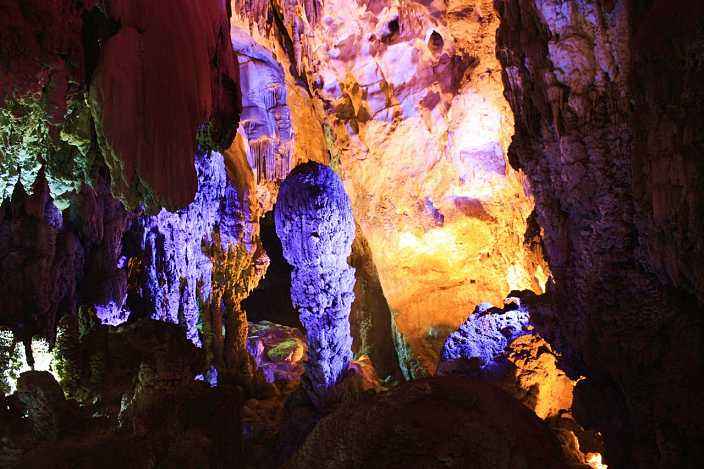
With its ethereal splendour and strangely beautiful rock formations, Zhijin Cave has often been described as a vast underground palace and appears to have been torn straight from the pages of a fairytale. In fact, the name “zhijin” literally translates to mean “weaving gold,” which should give you some idea as to how beautiful this cave system is. Located in the small village of Minzhai, Zhijin Cave is a karst cave that is 173 metres (568 ft.) wide and 150 metres (492 ft.) tall at its largest point. To put that into perspective, you could fit the entire Statue of Liberty into its largest cavern with plenty of room to spare! The cave itself is contained within a national park, which also includes Zhijin Old Town, the Jiehe Gorge, and the Hongjia Ferry.
What makes this cave system particularly special is that it is home to a dizzying array of karst formations and has even earned the nickname of the “Karst Museum.” Over forty different types of karst formations can be found throughout the cave system, which makes it reasonably unique amongst karst cave networks. In particular, it is home to rare karst formations made from semiolite, prehnite, and bloodstone, which endows the interior of the cave with a variety of magical shapes and colours. The sharp stalactites hanging from the ceiling and the piercing stalagmites rising from the floor give the interior of the cave an entrancing alien appearance. The average height of these rock formations is around 40 metres (131 ft.), although many of them reach heights in excess of 70 metres (230 ft.).The most notable of these is known poetically as the Silver Rain Tree, a rare transparent crystal that is 17 metres (56 ft.) in height and is said to resemble a flowering tree. Its sparkling beauty is sure to capture the imagination of anyone who sees it, although we wouldn’t recommend trying to eat its fruit!
The cave itself was originally known as Daji or “Hit the Rooster” Cave, which you may be surprised to hear goes back to the cave’s history as a playground for young children! Local children from the Miao ethnic minority used to gather in the cave to play a game known as “hit the rooster,” where participants hit a colourful feathered shuttlecock back and forth. Although these Miao communities would enter the cave from time to time, it wasn’t officially discovered until 1980, when the Zhijin County Tourism Resources Exploration Team delved deeper into the cave system. To date, they have already led expeditions as deep as 4 kilometres (3 mi) into the 12 kilometre (7 mi) length of the overall cave system. According to their findings, they have determined that the cave system is made up of 2 main caves and 4 branches caves, which have been divided into 4 layers and 47 chambers. Within each cave, the average height of the rock formations is around 40 metres (131 ft.), although many of them reach heights in excess of 70 metres (230 ft.).

When it comes to touring the cave system, it has been conveniently divided into 10 scenic zones: Yingbin Hall, the Sutra Hall, the Pagoda Forest, Wanshou Palace, Wangshan Lake, Jiangnanzeguo, Xuexiang Palace, Lingxiao Palace, Guanghan Palace, and the Shiwan Mountain. The first and arguably most magnificent sight you’ll be greeted by is the Yingbin or “Reception” Hall, which is over 200 metres (656 ft.) long. What makes this cavern particularly special is that its ceiling contains a large round hole that allows sunlight to pierce right into the bottom of the cave. This means that the entire hall is covered in thick green moss, which thrives in the damp conditions. The sunlight glistening off of the many water droplets that fall constantly from the ceiling of the cavern creates a scene like a thousand gold coins trickling down the rock. In fact, the hole in the cavern’s ceiling is even known as Luoqian or “Dropping Coins” Hole. Money may not grow on trees, but it seems that in Zhijin Cave it falls from the sky instead!
To the side of Yingbin Hall, there is a smaller cavern known rather darkly as Mushroom-Cloud Hall, because its main feature is a 10-metre (33 ft.) tall stalactite that supposedly resembles the shape of the mushroom cloud formed after a nuclear explosion. In-keeping with this hall’s gloomy aesthetic, there is also a small pond that has been aptly named Shadow Spring, because of the way that the shadows of the stalagmites dance eerily on the surface of the water.

The name of the Sutra Hall, by contrast, is derived from the fact that it is home to a stalactite that reputedly resembles a type of saintly Buddhist figure known as an arhat. The cavern itself is around 200 metres (656 ft.) in length and 50 metres (164 ft.) in width, with a pool at its centre that covers an area of about 300 square metres (3,229 sq. ft.). This pool has been divided into two parts by the famed arhat stalactite, which has earned it the name Riyue or “Sun and Moon” Pool. From the Buddhist figure guarding the cavern to the Yin-Yang elements of the Riyue Pool, it would be hard not to feel enlightened as you wander through the Sutra Hall!
Following the Buddhist theme, the Pagoda Forest is home to over 100 stalagmites, which are golden in colour and resemble a glistening forest of real pagodas. Near to this cavern is Wangshan Lake, which is an underground lake that is a staggering 170 metres (558 ft.) long and more than 40 metres (131 ft.) wide. To put that into perspective, this subterranean lake is over three times the length of an Olympic swimming pool!
Once you’ve enjoyed the many splendid natural attractions to be found within the cave, you can pay a visit to some of the ethnic minority villages that are dotted throughout the region. Zhijin Cave itself is located in an area populated by the Miao ethnic minority, although there are also settlements of Yi people and Bouyei people nearby. In particular, the Miao people who live near to the cave are well-known for their craftsmanship and their delicious local style of cuisine.